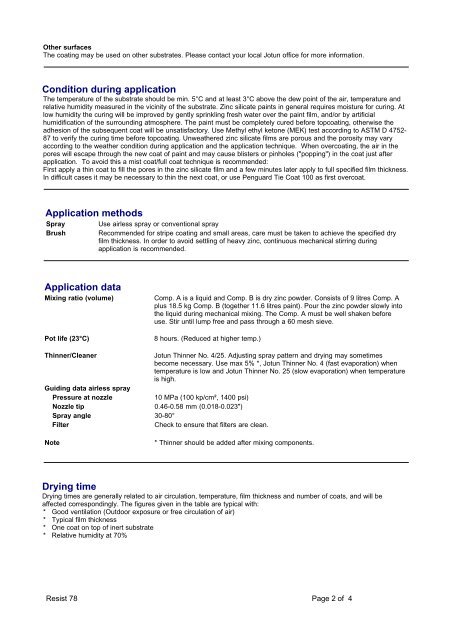English (United Kingdom) - Paul Wurth
English (United Kingdom) - Paul Wurth
English (United Kingdom) - Paul Wurth
- TAGS
- wurth
- www.paulwurth.com
You also want an ePaper? Increase the reach of your titles
YUMPU automatically turns print PDFs into web optimized ePapers that Google loves.
Other surfaces<br />
The coating may be used on other substrates. Please contact your local Jotun office for more information.<br />
Condition during application<br />
The temperature of the substrate should be min. 5°C and at least 3°C above the dew point of the air, temperature and<br />
relative humidity measured in the vicinity of the substrate. Zinc silicate paints in general requires moisture for curing. At<br />
low humidity the curing will be improved by gently sprinkling fresh water over the paint film, and/or by artificial<br />
humidification of the surrounding atmosphere. The paint must be completely cured before topcoating, otherwise the<br />
adhesion of the subsequent coat will be unsatisfactory. Use Methyl ethyl ketone (MEK) test according to ASTM D 4752-<br />
87 to verify the curing time before topcoating. Unweathered zinc silicate films are porous and the porosity may vary<br />
according to the weather condition during application and the application technique. When overcoating, the air in the<br />
pores will escape through the new coat of paint and may cause blisters or pinholes ("popping") in the coat just after<br />
application. To avoid this a mist coat/full coat technique is recommended:<br />
First apply a thin coat to fill the pores in the zinc silicate film and a few minutes later apply to full specified film thickness.<br />
In difficult cases it may be necessary to thin the next coat, or use Penguard Tie Coat 100 as first overcoat.<br />
Application methods<br />
Spray Use airless spray or conventional spray<br />
Brush Recommended for stripe coating and small areas, care must be taken to achieve the specified dry<br />
film thickness. In order to avoid settling of heavy zinc, continuous mechanical stirring during<br />
application is recommended.<br />
Application data<br />
Mixing ratio (volume) Comp. A is a liquid and Comp. B is dry zinc powder. Consists of 9 litres Comp. A<br />
plus 18.5 kg Comp. B (together 11.6 litres paint). Pour the zinc powder slowly into<br />
the liquid during mechanical mixing. The Comp. A must be well shaken before<br />
use. Stir until lump free and pass through a 60 mesh sieve.<br />
Pot life (23°C) 8 hours. (Reduced at higher temp.)<br />
Thinner/Cleaner Jotun Thinner No. 4/25. Adjusting spray pattern and drying may sometimes<br />
become necessary. Use max 5% *, Jotun Thinner No. 4 (fast evaporation) when<br />
temperature is low and Jotun Thinner No. 25 (slow evaporation) when temperature<br />
is high.<br />
Guiding data airless spray<br />
Pressure at nozzle 10 MPa (100 kp/cm², 1400 psi)<br />
Nozzle tip 0.46-0.58 mm (0.018-0.023")<br />
Spray angle 30-80°<br />
Filter Check to ensure that filters are clean.<br />
Note * Thinner should be added after mixing components.<br />
Drying time<br />
Drying times are generally related to air circulation, temperature, film thickness and number of coats, and will be<br />
affected correspondingly. The figures given in the table are typical with:<br />
* Good ventilation (Outdoor exposure or free circulation of air)<br />
* Typical film thickness<br />
* One coat on top of inert substrate<br />
* Relative humidity at 70%<br />
Resist 78 Page 2 of 4




